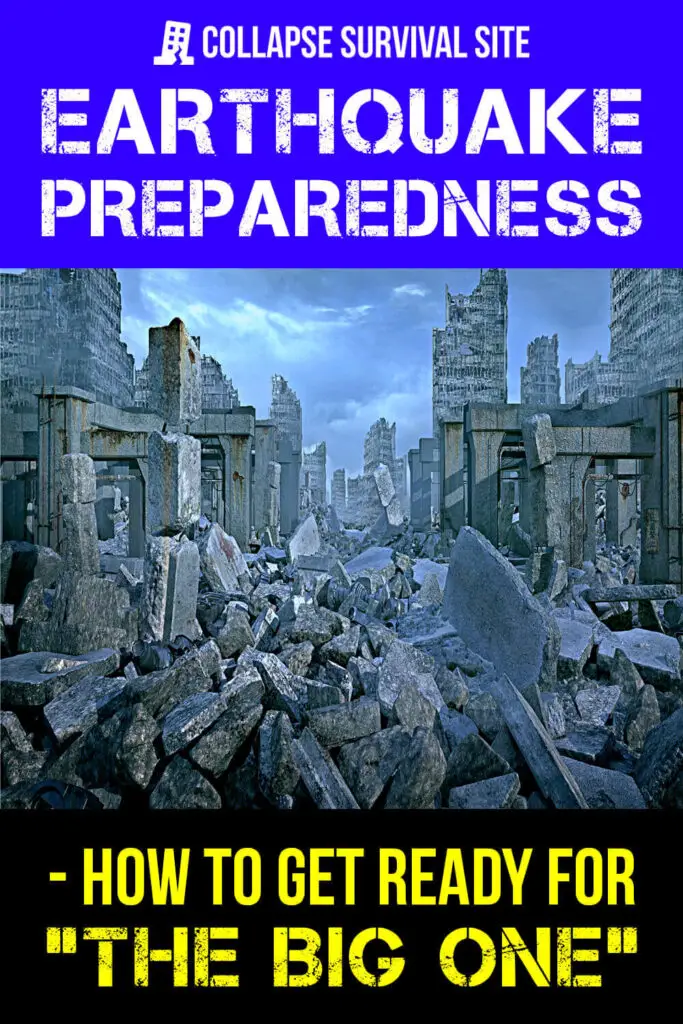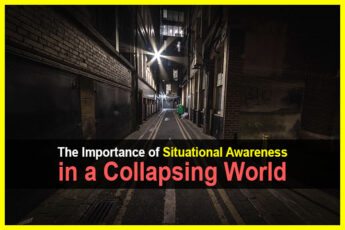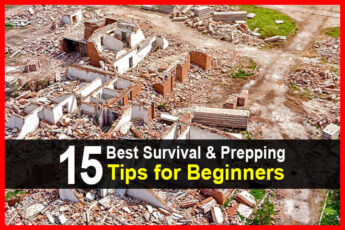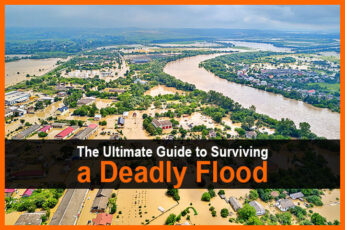Estimated reading time: 15 minutes
Earthquakes can be one of mother nature’s scariest events. They occur with little to no warning, and they shake the very foundation of the earth we are tethered to.
As I write this article I can’t help but think of the massive earthquake that hit the country of Turkey on February 6, 2023. The quake registered a 7.8, the largest that Turkey has experienced in decades. So far, it has left over a million people homeless, killed over 50,000, and resulted in over $100 billion in damages.
On the other side of the globe is The United States, which is no stranger to earthquakes. According to the USGS, “we expect about 16 major earthquakes in any given year. That includes 15 earthquakes in the magnitude 7 range and one earthquake magnitude 8.0 or greater.”
Want to save this post for later? Click Here to Pin It On Pinterest!
While there are several faults in the United States, California seems to be a hotbed of earthquakes as it sits on several of them, including the well-known San Andreas fault line. The San Andreas fault line is where the North American Plate and the North Pacific Plate meet and the confrontation of these two giants can cause a lot of problems.
Many experts warn that California is overdue for what they call, “the big one,” which will certainly be larger than a 7.0 and most likely 8.0 or greater. According to a ZME Science article based on a USGS model, “report shows California has 99% chances of big earthquakes in 30 years.”
As population centers grow, the aftermath of “the big one,” is only going to get worse. Take a minute to imagine the following.
The sun is shining across a blue sky and you are going about your day like any other. Your mind is preoccupied with family, bills, and what to make for dinner when suddenly the ground starts to shake.
But this is no gentle back-and-forth shaking, more like a small boat being thrown around in the middle of a hurricane. Vehicles are skidding around on the road. Every time you try to balance yourself you are heaved to one side.
Steel, concrete, and glass rain down from above. Bridges and overpasses collapse, dropping vehicles to the ground and crushing or trapping those below. And the very earth itself falls away in some areas, opening into black chasms.
Then everything goes still. However, you will still have to contend with broken pipes spewing sewage, water, and gas. Down electrical lines that are still live and lay like silent traps.
Fires that spread from one building to the next, and the next. Possible tsunamis, aftershocks, and looters looking to take what they can. And this is if you are lucky enough to not be trapped under a pile of rubble.
A rather dark situation to imagine, but you can better your chances of living through such a scenario by learning as much as you can and preparing for when the inevitable will happen.
How To Prepare
You may think that the situation is grim when it comes to earthquakes but there are several things you can do before, during, and after an earthquake that will help you to survive.
Retrofitting and New Construction
New construction has to abide by newer codes that should give the building some protection from earthquakes. If you own your home but the construction is older, you can look into retrofitting it with “earthquake-proof” measures. These may be costly upfront but they could save your home from severe damage and even save your life down the road.
Other measures include securing “loose” items within your home to prevent them from becoming falling hazards or projectiles. Items such as books or decorations on a shelf, televisions, hanging pictures, bookcases and other furniture. Some of these items can be secured with straps, specialty hooks, and even heavy duty velcro.
Check out this video for more ideas:
Know Where It’s Safe
Locate safe zones within your home and the buildings you frequent the most. By knowing where safe areas are, you can act quickly to get out of harm's way when a quake happens.
Practice
Run drills of what to do during an earthquake. Don’t just make plans and don’t just talk about them. Take a weekend to run a proper drill and figure out what you would do if you are cut off from the outside world for several days. This includes living without amenities such as water, gas, and electricity.
It is also important to create an evacuation plan that you can implement in case the area becomes too dangerous to stay in. Take notes of everything you learn from running drills and keep your plans organized and easily accessible by putting them in a three ringed binder.
Know Your Utilities
Locate your breaker box, gas main, and water main. Obtain the tools and the knowledge to shut these utilities off properly and safely should they become damaged.
A breaker box has a main breaker that can simply be flipped to the off position but gas and water mains usually require tools to turn them off. Adjustable wrench or channel locks can be used or you can purchase a specialty tool like this 4 in 1 Emergency Tool for gas and water valves. No matter what tools you get, be sure to keep them near the mains so that you can shut them down quickly.
First Aid Training
Go through first aid classes so that you know how to handle common and life-threatening injuries in case first responders can’t get to you in time. The American Red Cross offers a lot of training programs on this topic and several of them can be completed online.
Other first aid and medical training courses include those offered by Refuge Medical and The Patriot Nurse
Emergency Supplies
In this section, I’m gonna talk about two different aspects of your emergency supplies, the supplies themselves and the location of those supplies. Let’s start with putting together some emergency supplies.
Fire Safety
Dealing with fires after an earthquake is something you definitely need to be prepared for. Broken gas pipes and damaged electrical systems can cause many fires throughout the affected area.
There are a few things you can and should do to better prepare yourself for a fire. First, install smoke detectors and carbon monoxide detectors throughout your home. Make sure they are battery-operated and that you test them regularly.
Next, get yourself a lot of fire extinguishers. Most people only get one but if you really want to be prepared then get one for each room of the home. This may seem like overkill, but remember that emergency services are going to be overwhelmed after an earthquake so they may not be able to respond promptly.
A fire escape ladder may also be something to consider getting if you live in a structure that has more than one level.
Water
Water mains will likely break or water sources will become contaminated. You need to store as much potable water as you can as well as the means to filter and purify water.
A water filter like the Sawyer Mini will allow you to filter up to 100,000 gallons of water and a heat source will allow you to purify the water through boiling. Another option is the Sechelle water filter bottle which has a filter built right into the bottle.
When storing water and calculating your needs, keep in mind that you will require water for drinking, cooking, and sanitation. Many people use the rule of thumb of one gallon of water per person per day but even just for drinking, that is too low. I would recommend no less than a minimum of three gallons of water per person per day.
Food
If you don’t want to worry about a backup heat source, i.e. a stove, then canned goods are a great item to store. They are pre-cooked, can be eaten right out of the can, and have a long shelf life without having to be refrigerated.
On the other hand, if you decide to go with freeze-dried or dehydrated meals or any food that needs to be cooked, then you will need to have extra water on hand and an alternative heating source, such as a camping stove.
The way you eat is going to be a bit different as well since it is likely you won’t be able to do dishes afterward and you don’t want to waste your bottled water on cleaning dishes. To save water get yourself some disposable plates, utensils, and heavy-duty trash bags.
Sanitation
Sanitation is always a big problem in any disaster. After a large earthquake, it is entirely possible you won’t have access to clean water for drinking, bathing, washing your hands, and using the toilet.
Keep your hands clean by using minimal potable water and soap when washing your hands. Water usage can also be reduced by using hand sanitizers.
Toilets may be unavailable but you are still going to need to “do your business.” There are a lot of different types of alternative toilets to choose from but a simple camping toilet should serve you well. If worst comes to worst you can always conduct your business into heavy-duty garbage bags and set them aside until they can be properly disposed of.
Medical
According to FEMA, the most common injuries from an earthquake are those sustained from building collapses and falling debris with the second leading cause being from hazardous materials and spills.
A regular first aid kit isn’t going to be enough when serious injuries happen. Since hospitals will be overflowing with patients and first responders stretched thin, it will be on you to take care of your medical needs. Build yourself a proper trauma kit that can deal with life-threatening issues such as severe blood loss and other critical injuries.
PPE
PPE stands for personal protective equipment and it refers to safety items like hard hats and gloves.
A lot of people neglect this category when it comes to emergency kits but an earthquake kit really should have this stuff because you may have to sift through or climb over rubble, deal with broken glass, be protected from falling hazards and huge amounts of dust, and deal with general debris.
For these reasons, you should get yourself a hardhat, heavy-duty work gloves, eye protection, dust masks, and joint pads.
Emergency Whistle
Emergency whistles are great for signaling for help over long distances or if you become trapped underneath the rubble. JetScream and HyperWhistle are two great products that will help alert others to your location.
Lighting
Every emergency kit should have candles in them but they should be used as a backup due to fire safety issues and they should only be used if you are one hundred percent certain there are no gas leaks in your home.
Get yourself some rechargeable flashlights, lanterns, and hanging LED bulbs to light up the areas you need to. Since they are rechargeable you will need a backup power source.
Miscellaneous Tools
Having a set of basic tools should be in every emergency kit because you don’t know what you will run into. Helpful items include pliers, a wire cutter, screwdrivers, and a hammer. Adding in a crowbar or a large prybar will be extremely helpful in moving heavy debris. Add in any specific tools you will need to turn off your property's utilities, like an adjustable wrench.
Plastic Sheeting and Duct Tape
Any damage done to your home or vehicle isn’t likely to get fixed quickly. Thick plastic sheeting and duct tape will help to temporarily shore up any breaches in your home, such as broken windows.
Backup Power
Unless you are set up to completely live without power, some level of backup power generation will be needed. Generally speaking, there are three different levels to choose from, small-scale, medium-scale, and large-scale.
Small-scale power backups would be portable power banks and solar panels that are easily carried or packable like a SunJack. These types of units allow you to power and recharge small devices like a laptop, smartphones, or radios.
Medium-scale power backup units are larger but still somewhat portable, such as larger solar panels that charge a battery bank like the Jackery or a gas powered generator. These units can power small devices and some small appliances.
Large-scale backup power would include whole home generators. These units are costly and are permanent fixtures, however, they can provide all of the energy needs to a home as long as the unit has fuel. Solar and wind can be large-scale backups but given their pitfalls and ease of damage in an earthquake, I would consider a large generator first.
Supplies Location
There are two schools of thought here. First, figure out the safest, most secure location in your home, i.e. the place most likely to hold up during an earthquake, and store your supplies there.
Or, split the supplies up into smaller kits and spread those kits throughout your property. This way, if the part of your home containing your supplies becomes damaged, you will still have access to other supplies.
Emergency supplies should be kept inside hard containers with lids so that they are protected from any fallen debris or water. If these containers are stored on shelves be sure they are secured and cannot fall out.
What To Do During An Earthquake
This section will be split into two parts, what to do during an earthquake if you are indoors and what to do if you are outdoors.
Indoor
As soon as an earthquake begins or you have been warned of one, immediately get to your safe zone. Drop down on all fours if you have to as you could be thrown off balance if you are standing up. Position yourself under a sturdy piece of furniture, such as a dining room table, to help protect yourself from falling debris.
However, if the area around the exterior of your home is open and free from buildings, trees, or other falling hazards, it may be safer to run outside.
Don’t leave your safe zone immediately after the main quake passes because aftershocks can occur. Be patient and wait for the all-clear signal from authorities if possible.
Outdoors
If you are outdoors when an earthquake happens, move away from any falling hazards and buildings and get to an open area. Do not shelter under bridges, overpasses, or inside tunnels as they are subject to collapse.
If you are on the road and driving during an earthquake, pull off to the side of the road, shift the vehicle into park, and stay inside the vehicle if it is safer to do so.
How To Survive The Aftermath
You may think that once an earthquake is over you are safe but the aftermath is filled with dangers you need to remain aware of.
Aftershocks
After the quake has passed it's important to realize that tremors or aftershocks can follow, so use your best judgment and caution when leaving your safe zone. Aftershocks can be tricky business as they have been known to pop up days after an earthquake.
Gas
If you smell gas, notify the utility company, attempt to shut the main off if possible, or leave the area immediately. Learn to turn off your utilities by following the steps in this video.
Power Lines
The effects of an earthquake can certainly bring power lines down and these can be extremely dangerous if the power hasn’t been shut off. You don’t have to touch the powerline itself for it to hurt you as it can charge the area around where it has fallen.
This is why it’s important to stay in a vehicle where you have become trapped by a downed powerline, simply touching the ground within the vicinity could electrocute you. Stay far away from powerlines that are on the ground and should you become trapped inside of a vehicle due to a down power line, the safest course of action is to stay in your vehicle until the power has been turned off.
In the event that you have to leave a vehicle due to smoke or fire, follow these steps on Power Line Vehicle Escape.
Fires
Fires can be abundant after an earthquake due to broken gas pipes and damaged electrical systems. Fire departments will likely be overwhelmed and some blazes will get out of control.
This is why it is so important to have a robust firefighting system of your own and an evacuation plan in place to leave the area if fires become too intense. For more tips on how to handle fires in your home, check out this video.
Tsunamis
Tsunamis occur when there is a major displacement in a body of water due to an impact, explosion, eruption, landslide, or earthquake. What’s important to understand about tsunamis is that an earthquake doesn’t have to occur in your region for a tsunami to happen.
In fact, an earthquake thousands of miles away can send a tsunami to your doorstep.
When a tsunami warning is issued you must get to the highest ground possible or as far inland as you can, quickly. If you see a body of water receding at a time that it shouldn’t, or receding more than it should and it is doing so in a short period, this is a warning sign that a tsunami is on its way.
When shorelines recede during a tsunami, many people make the mistake of venturing further out onto the exposed seafloor. Don’t do this as you will easily be overtaken by the incoming deluge of water.
For more tips on how to survive a tsunami, check out this video.
To see what a tsunami is capable of, check out this footage from National Geographic.
Looters
It’s an unfortunate fact that when big events happen, like natural disasters, some people look to take advantage of the chaos. After a disaster like an earthquake, emergency services will be overwhelmed and stretched thin doing their best to help those in need. While this is going on, other people will be looting businesses and homes for their own personal gain.
After an earthquake, it is critical to stay situationally aware, not only of the direct effects of the earthquake but of those looking to take advantage of the situation and looters. I can’t tell you how to handle this situation exactly but some businesses and homeowners have found it necessary to defend their property with armed guards until order has been re-established.
For more information on how to defend your home, check out this awesome four part series on home defense by Warrior Poet Society.
Conclusion
California has certainly experienced some big earthquakes in the past, with even larger more destructive ones predicted for the future. Earthquakes are one of mother nature’s scariest events because they literally move the foundation of the earth and it can feel like there is nowhere safe to go.
This doesn’t mean you should simply throw your hands up and shrug your shoulders and succumb to the doom and gloom of these very likely events because there is quite a bit that you can do to prepare yourself and your loved ones.
Where there is a will, where there is hope, there is always a way, and I encourage you to take the steps needed to prepare for the next earthquake.
Like this post? Don't Forget to Pin It On Pinterest!








